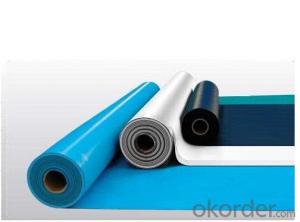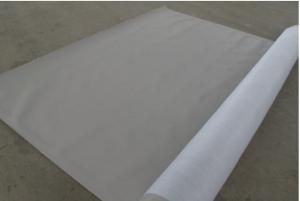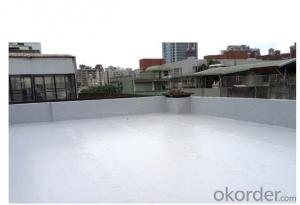PVC Roofing and Waterproof Building Membrane
- Loading Port:
- Qingdao
- Payment Terms:
- TT OR LC
- Min Order Qty:
- 2000 m²
- Supply Capability:
- 300000 m²/month
OKorder Service Pledge
OKorder Financial Service
You Might Also Like
Introduction of PVC Waterproof Membrane
It is an excellent high quality polymer waterproof sheet, made of PVC resin by adding plasticizer, anti-UV agent, anti-aging agent, and stabilizer and other processing aids through extrusion and molding.
As the highly recommended product by the Ministry of Consturction, it is featured by high tensile strength, great elongation, good stability, small shrinkage, low temperature performances, good resistance to weathering and root penetration and long service life.
.
Features of PVC Waterproof Membrane
1)Excellent aging resistance. Service life of roofing material is over 20 years; service life of underground material is over 50 years.
2)Root resistant penetration, specially used on planting roofings.
3)Welding installation. Joints are solid and environment friendly, no pollution.
4)High tensile strength, good elongation and dimensional stability.
5)Good plasticity, easy and suitable for details installation.
6)Fireproof. Fire extinguished out of the ignition resource.
7)Surface is smooth, no fading and dirty resistant.
8)Width is over 2m. Construction wastage is small, more economical.
Classification and Specification of PVC Waterproof Membrane
N: Homogeneous PVC membrane
L: PVC membrane with fabric backing
W: Reinforced PVC membrane
Thickness: 1.2mm/1.5mm/2.0mm
Size: 2.05mx20m
Color: white/grey, or any other colors.
Advantage of PVC Waterproof Membrane
1.) Mixing automation. Apply automatic temperature control automatic time control and automatic feed control.
2.) Extrusion equipment uses twin screw coextrusion. Screw temperature uses computer automatic temperature control system.
3.) Handpiece uses large width didhead extrusion equipment.
4.) Sophisticated three-roller calender equipment. The space between equiment is controlled by automation system.
Technical Data of PVC Waterproof Membrane
No. | Item | Model Ⅱ | |
1 | Tensile Strength Mpa ≥ | 12.0 | |
2 | Elongation at break% ≥ | 250 | |
3 | Shrinkage rate % ≤ | 2.0 | |
4 | Flexibility at low temperature | No crackle at -25oC | |
5 | Water tightness | Watertight | |
6 | Puncture resistance | Watertight | |
7 | Heat aging treatment | Appearance | Free from bubble, crack, cohesion and void |
Change rate of tensile strength % | +20oC | ||
Change rate of elongation at break | |||
Flexibility at low temperature | No crack at -20oC | ||
8 | Chemical corrosion resistance | Change rate of tensile strength % | +20 |
Change rate of elongation at break | |||
Flexibility at low temperature | No crack at -20oC | ||
9 | Artificial weathering | Change rate of tensile strength % | +20 |
Change rate of elongation at break | |||
Flexibility at low temperature | No crack at -20oC | ||
Application of PVC Waterproof Membrane
PVC membrane applies special formula and its service life is much longer than other general waterproof membranes. Its excellent performance makes it be widely used in every field.
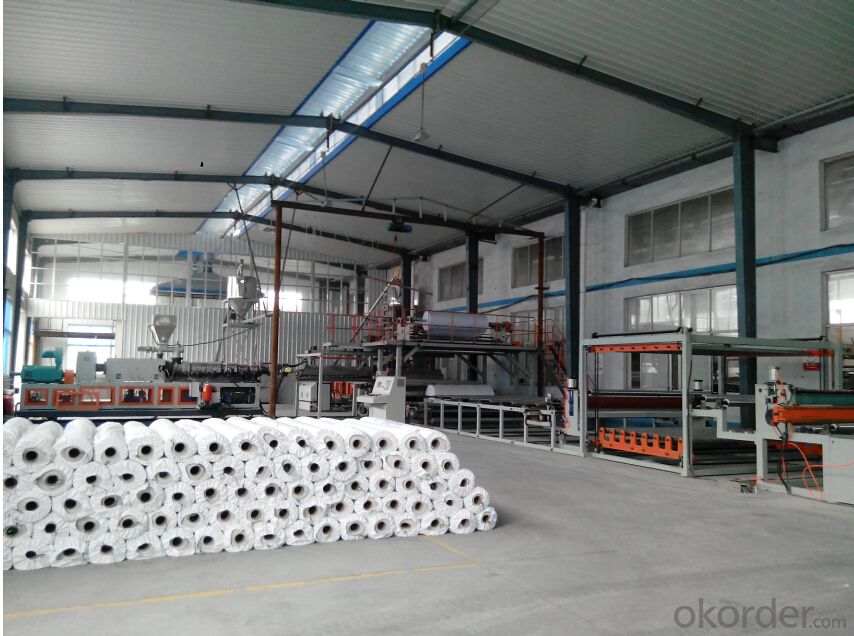
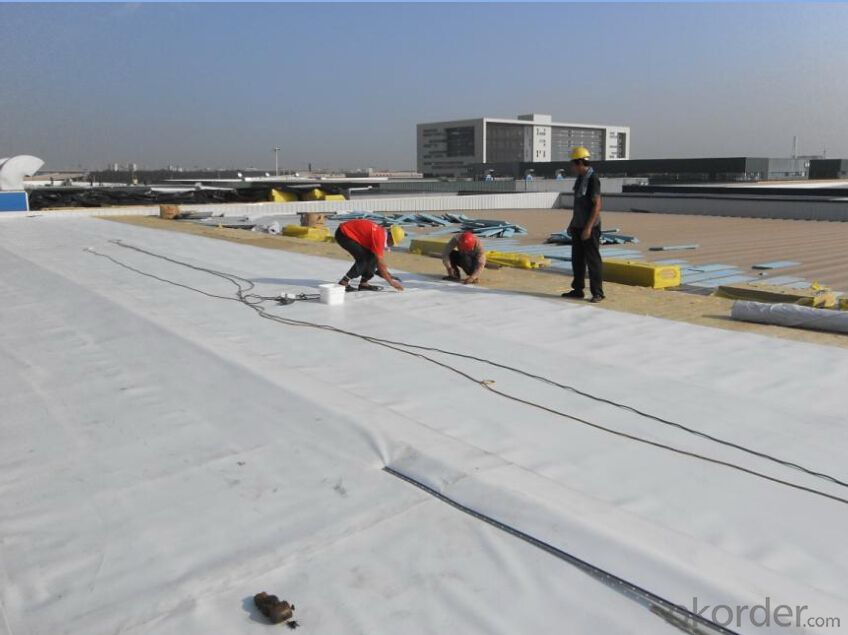
FAQ:
Can you produce 4m width?
Yes, no problem for us. We have four bases in China, largest one in this field.
How many quantity in one 20'' container for 1.2mm and 1.5mm?
480rolls, 11520m2 for 1.2mm and 400rolls, 9600m2 for 1.5mm
Can you provide free samples?
Yes, our samples are free, but express fees usually on buyer's account.
- Q:Can a waterproofing membrane be used in areas with chemical exposure?
- Yes, a waterproofing membrane can be used in areas with chemical exposure. However, it is essential to choose a membrane specifically designed to withstand the chemicals present in the environment. The membrane should have chemical resistance properties and be compatible with the specific chemicals it will be exposed to in order to provide effective protection against water damage and chemical degradation.
- Q:Are waterproofing membranes resistant to earthquake movements?
- Waterproofing membranes serve the purpose of safeguarding structures, such as buildings and basements, from the invasion of water and moisture. While they effectively prevent water damage, they are not specifically engineered to withstand or endure the movements caused by earthquakes. Earthquakes involve the shaking and displacement of the ground, which exert considerable forces on structures. Waterproofing membranes do not typically possess the ability to absorb or distribute these forces in the same manner as seismic-resistant materials or building techniques. Nevertheless, it is important to note that certain waterproofing systems may exhibit a certain level of flexibility or elasticity, which could potentially offer some resistance against minor ground movements during an earthquake. These characteristics may assist in maintaining the integrity of the membrane and preventing water infiltration if slight shifting or settling occurs. Ultimately, when it comes to earthquake resistance, it is vital to employ specialized seismic design principles and techniques that are suitable for the specific location and building requirements. In order to ensure overall structural integrity and safety during seismic events, waterproofing membranes should be utilized in conjunction with these seismic-resistant measures.
- Q:Can a waterproofing membrane be used on concrete slabs or foundations?
- Yes, a waterproofing membrane can be used on concrete slabs or foundations. Waterproofing membranes are commonly used in construction to prevent water penetration and protect structures from moisture damage. By applying a waterproofing membrane to a concrete slab or foundation, it creates a barrier that prevents water from seeping into the concrete and causing potential issues like cracking, water damage, or mold growth. This membrane is designed to withstand hydrostatic pressure, which is the force exerted by standing water, and it can effectively keep the area dry. It is important to select a suitable waterproofing membrane that is compatible with concrete and the specific conditions of the project. Proper installation and maintenance of the membrane are also crucial for long-term waterproofing effectiveness.
- Q:Can a waterproofing membrane be used on sloped roofs?
- Yes, a waterproofing membrane can be used on sloped roofs. In fact, it is often recommended to use a waterproofing membrane on sloped roofs to prevent water infiltration and potential leaks. The membrane acts as a barrier, preventing water from seeping into the roof structure and causing damage. Additionally, the membrane can also help to protect the roof from other elements such as UV rays, temperature fluctuations, and mechanical stresses. It is essential to choose a waterproofing membrane that is specifically designed for sloped roofs and is compatible with the roofing material to ensure long-lasting protection.
- Q:Does a waterproofing membrane provide any additional structural reinforcement?
- No, a waterproofing membrane does not provide any additional structural reinforcement. Its primary purpose is to prevent water penetration and protect the underlying structure from moisture damage. Structural reinforcement typically requires other methods such as steel reinforcement, concrete additives, or structural members like beams and columns.
- Q:Can a waterproofing membrane be used in tunnels?
- Yes, a waterproofing membrane can be used in tunnels. Waterproofing membranes are commonly used in tunnel construction to prevent water infiltration and protect the tunnel structure from damage caused by moisture. These membranes are designed to provide a barrier against water, keeping the tunnel dry and secure.
- Q:Can a waterproofing membrane be used on roofs with skylights?
- Yes, a waterproofing membrane can be used on roofs with skylights. The membrane is typically installed around the skylight opening to ensure a watertight seal and prevent any leaks or water damage.
- Q:Can waterproofing membranes be used on concrete tunnels?
- Yes, waterproofing membranes can be used on concrete tunnels. Waterproofing membranes are commonly used in construction to prevent water infiltration and protect structures, including concrete tunnels, from moisture damage. These membranes create a barrier that prevents water from seeping through the concrete and into the tunnel, ensuring its durability and longevity.
- Q:Can a waterproofing membrane be used for a rooftop garden?
- Indeed, a rooftop garden can benefit greatly from the utilization of a waterproofing membrane. Specifically designed to obstruct water infiltration, this product proves to be an optimal solution for safeguarding the building structure against water-induced harm. By implementing a waterproofing membrane on the rooftop, a protective shield is established, effectively warding off any potential seepage into the underlying layers. Consequently, the installation of this barrier guarantees the preservation of the building's integrity, shielding it from potential leaks and water damage. This measure holds particular significance in the context of rooftop gardens, given that the weight of the soil and vegetation heightens the risk of water infiltration. Thus, the utilization of a waterproofing membrane ensures the structural stability of the rooftop garden, effectively averting any water-related complications.
- Q:Does a waterproofing membrane require any maintenance?
- Yes, a waterproofing membrane typically requires some maintenance to ensure its effectiveness over time. Regular inspections, repairs, and cleaning are recommended to prevent any damage or deterioration.
1. Manufacturer Overview |
|
|---|---|
| Location | |
| Year Established | |
| Annual Output Value | |
| Main Markets | |
| Company Certifications | |
2. Manufacturer Certificates |
|
|---|---|
| a) Certification Name | |
| Range | |
| Reference | |
| Validity Period | |
3. Manufacturer Capability |
|
|---|---|
| a)Trade Capacity | |
| Nearest Port | |
| Export Percentage | |
| No.of Employees in Trade Department | |
| Language Spoken: | |
| b)Factory Information | |
| Factory Size: | |
| No. of Production Lines | |
| Contract Manufacturing | |
| Product Price Range | |
Send your message to us
PVC Roofing and Waterproof Building Membrane
- Loading Port:
- Qingdao
- Payment Terms:
- TT OR LC
- Min Order Qty:
- 2000 m²
- Supply Capability:
- 300000 m²/month
OKorder Service Pledge
OKorder Financial Service
Similar products
New products
Hot products
Related keywords
